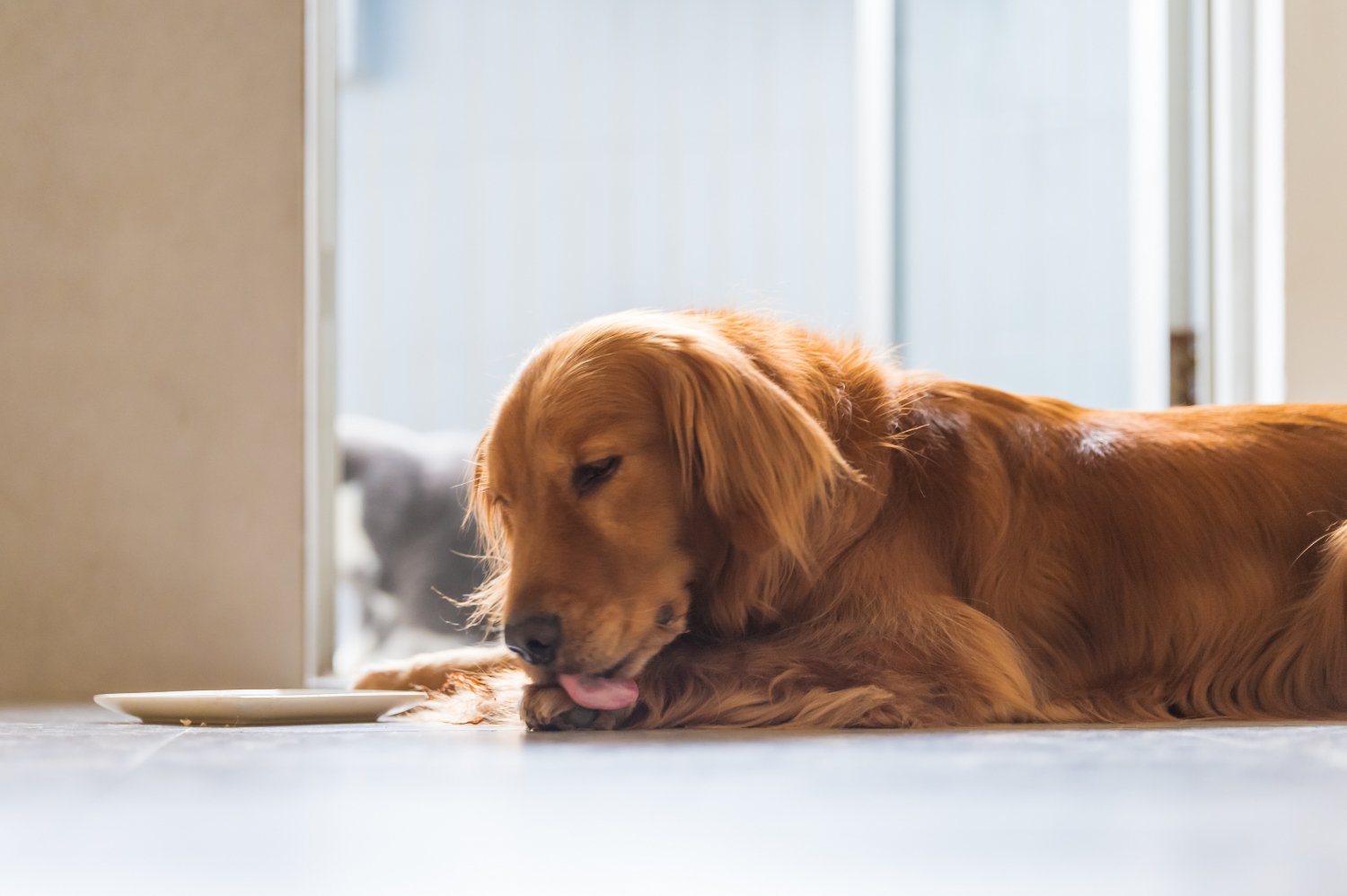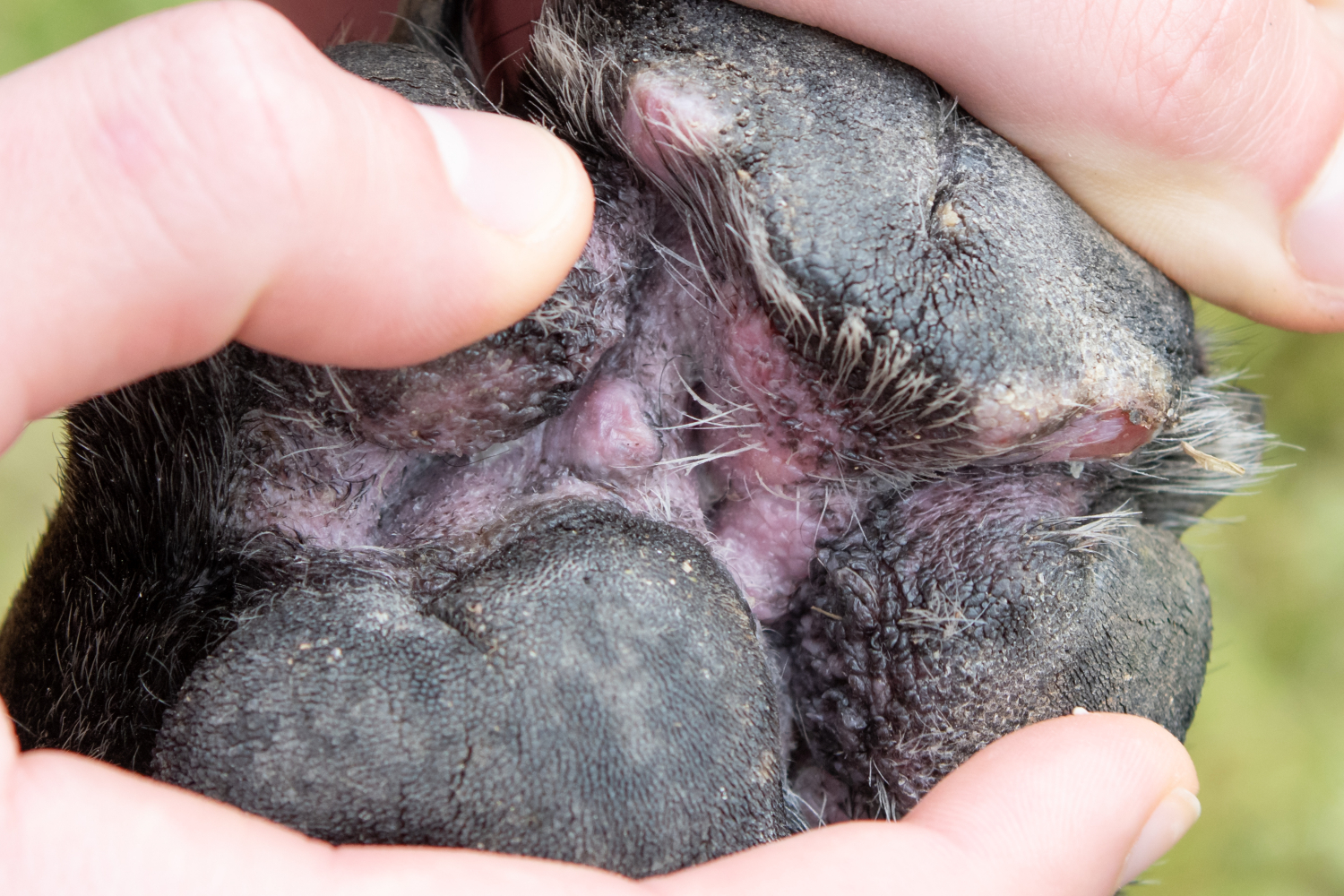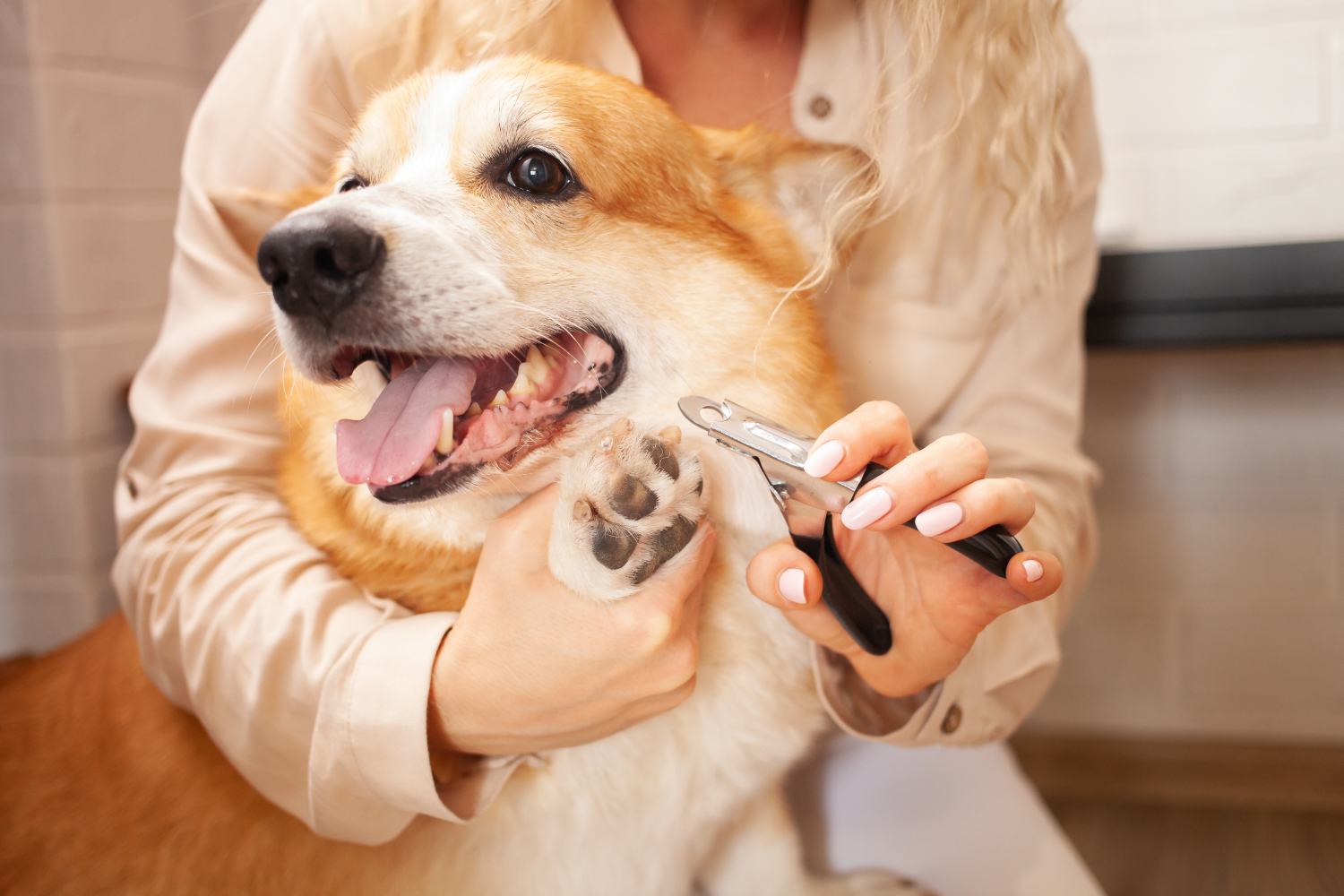
Why do dogs lick their paws?
29th December, 2022
Is your dog licking their paws more than usual? Here’s how to spot the signs of paw problems so you can get your pup back on their feet.
There’s nothing cuter in our book than seeing a tiny pup with massive paws! But they soon grow into them and it’s your job as a responsible pet parent to make sure those precious pads stay in tip-top condition throughout your dog’s life.
As canines age, the skin on those pads becomes softer, thinner and more prone to injury. And a poor old pooch hobbling around the house is a heart-breaking sight indeed.
What can you do to help? Those pads need some proper TLC. And we’re not just talking about the odd doggy pedicure every now and then.
A dog’s paws aren’t just made for walking. They help them grip onto treats and toys. They’re also essential for temperature control.
Did you know your dog sweats through its feet? That’s why standing a hot pooch in cold water can help cool them down.
All in all, your canine’s paws are pretty awesome. That’s why they deserve to be protected with senior dog pet insurance from the pros.
There’s also lots you can do to keep those paws in top shape, too, so let’s take a closer look at these fascinating feet and how you can step in to help.
What type of feet does your dog have?
That might sound like a bit of a crazy question, but let us explain. While human feet are all pretty much the same, canine feet come in three different types:
1. Cat feet
Does your dog have a neat, round paw with a high arch? Are their toes close together? This type of paw is built for endurance and grip, so mainly seen on working breeds.
Dogs like the Doberman Pinscher and Akita have cat-like feet – minus the retractable claws, of course!
2. Hare feet
If you’ve got an old Greyhound, you’ll be familiar with those long central toes. Built for short, sharp bursts of speed, you’ll also see hare feet on whippets and Samoyeds.
3. Webbed feet
Why would a dog need webbed feet? That’s right – to work in the water! Hounds who’ve been bred to retrieve fishing nets or game birds have webbed feet to help them power through the waves.
Webbed feet can be spotted on breeds like the Newfoundland and Portuguese water dog.
Perfectly adapted but still delicate, these types of paws are prime candidates for foot problems, so keep a close eye on your old canine or you could be claiming on your senior dog pet insurance before too long.
What about their toes?
Well, most dogs have 18 toes in total. Yes, 18! That’s five toes on the front legs (including that sneaky dew claw) and four toes on the back.
Nails have a hard outer shell, a softer inner shell and the quick - the cuticle containing blood vessels and nerves. If you happen to snip the quick when trimming their nails (see more below), you could have a very unhappy canine on your hands - and lots of blood, too!
So, what are dew claws for?
Dew claws don’t really serve a purpose. They’re like your dog’s immovable thumb! In the old days, dew claws used to help dogs pin down their prey, but as canines became more domesticated, they had less and less need for them.
If your older dog is wrestling with a large bone, you might see them use their dew claw, but other than that, they stay well hidden.
In fact, the only time when dew claws can become a problem is when they get caught on something and rip, or when they become overgrown and start digging into your dog’s skin. They sit high up on your pet’s ankle so they don’t get worn down during normal exercise time.
If your dog gets an injury on their leg, your vet might decide to remove the dew claw, but other than that, they should be left well alone.
12 reasons dogs lick their paws
Your old dog loves nothing more than having a good, thorough lick of their paws when they’re curled up in their bed, right? And so they should.
Licking is a natural, self-grooming behaviour that helps to keep their paws clean. It’s probably quite soothing, too, and a sign that your old hound is content as can be.
Or are they?
If you’ve noticed your canine concentrating on just one paw - licking and chewing much more than usual - something is afoot (excuse the pun!) and your pet parent radar should start kicking in.
Let’s look at some of the top reasons why your pooch’s paws could be causing them problems.
Foreign objects
Does your old dog still love diving into hedges? Sprinting off into the woods? Racing around the park? Then the likelihood of them hobbling back with a thorn, piece of glass or grass seed stuck in their tootsie is pretty high.
Bleeding from a cut will be easy to spot, but grass seeds can be trickier.
Is a grass seed in a dog’s paw an emergency? If you can’t easily remove it with tweezers, we’d recommend getting your canine to the vets immediately.
If the seed works its way deeper into the skin, surgery may be needed to remove it. Sounds expensive, right? Don’t worry. Your senior dog pet insurance could help cover the costs.
Injuries
Burns from hot tarmac, lesions from ice and snow, cuts from sharp brambles. Your adventurous pooch can pick up paw injuries pretty much anywhere.
- Clean the wound with salt water two or three times a day max.
- Stop your dog from licking its wounds by using a collar, bandage or protective sock.
- If there are signs of infection like swelling, heat, discharge or redness, take them to the vets - they may need antibiotics.
If you have senior dog pet insurance through Petwise, you can use our 24/7 vet video consultation service for advice.
For more major cuts or wounds, don’t delay. Try to stem or cover any bleeding and take your dog to the vet straight away.
Torn nail
If your older dog’s nails are brittle or cracked, they’ve got more chance of being injured, cracked or ripped off completely. Ouch!
A nail injury near the nail bed will usually bleed a lot, so it’s best to stem the bleeding and get your pet to the vet as soon as possible.
Try not to let your dog walk on its injured paw, as this will only make the bleeding worse.
Your dog with a ripped nail will be in a lot of pain, so watch out for aggressive behaviour. They will also try to lick their paw, but it’s your job to stop them from doing that – you don’t want to introduce an infection to the wound.
Dogs Trust has a great little guide on how to trim your dog’s nails at home. Keeping them nice and short will reduce the risk of ripping, so it’s worth taking a look at the advice.
We’ll summarise it here:
- Place the clippers on the ground, surrounded by treats, and let your dog investigate.
- Touch your dog’s paw and then let them have a good sniff of the clippers. Praise them and give them a treat to establish a positive association.
- Touch the actual nail and then offer another treat.
- Squeeze the clippers so they get used to the noise, while touching their nails at the same time.
- Cut one nail at a time, concentrating on the very tip. Don’t cut too far down – stay away from the quick to avoid bleeding.
Parasites
Have you noticed red, scaling skin around your hound’s eyes and feet? The culprit could be tiny Demodex mites. This sneaky skin parasite is usually found in puppies or dogs with other illnesses.
So, if your older pooch has additional health problems, be on the lookout for mites, too.
You won’t spot these critters without a microscope, so your dog licking their paws could be the first sign of an infestation.
Tablets, spot-on treatments or shampoos are usually recommended to fight the bugs, but it can take weeks or even months to get rid of the mites – especially if your senior dog is fighting other health problems.
Skin condition

If your dog is licking and chewing their paws like crazy, they could have a spot of pododermatitis. Also called interdigital dermatitis, this is when the skin between your dog’s toes and soft foot pads becomes super-itchy and inflamed.
It can be caused by a whole host of nasties including ringworm, a parasitic infection, allergies or trauma. Obesity can also put extra weight on the pads, which can lead to pododermatitis developing (as well as a myriad of other health concerns).
Treatments might include antibiotics and antifungal medications, along with a change of diet if your hound has piled on the pounds.
If the cause is something more serious like a tumour, then surgery or radiation treatment might be the answer. Your senior dog insurance plan might be able to help with the costs of treatments like this – check to see what’s included in your policy.
Allergies
Could your hound’s constant licking be caused by allergies? Everything from mould to pollen could cause your dog’s paws to crust up!
Ask your vet to do an allergy test to identify possible triggers and then remove them from your four-legged friend’s environment as best you can.
Cyst or tumour
Remember those webbed feet we were talking about earlier? Well annoying cysts can develop between your canine’s toes, causing discomfort, pain and, you’ve guessed it, lots of licking!
Look out for red lumps, ulcerated sores and inflammation on those poor pads. As this is a painful condition, they’ll probably be limping a lot, too.
Being overweight or having thyroid problems can trigger cysts, so try to always keep your dog at a healthy weight for their size and age.
Labradors, Bull terriers, German Shepherds, Bulldogs and Basset Hounds commonly suffer from this kind of paw problem.
Animal or insect bite
When your old dog is doing its best puppy impression and racing across the fields, the last thing they’re expecting is to get bitten by a snake! But an adder bite can be serious, even life threatening, so if you think your pooch has been bitten, a trip to the vets is definitely on the cards.
Venom causes swelling, so your dog will usually lick the wound or hold up their poorly paw to avoid putting weight on it.
The quicker your dog is treated, the better chance they have of surviving, so quick action is key. If you spot the offending snake, try to take a picture to show the vet.
Emergency treatment is usually covered under a senior dog pet insurance plan. Check your Petwise policy to see what’s included now.
Sprain
If your dog still enjoys their regular runs, they could be risking getting a sprain. Don’t get us wrong, exercise is obviously key to keeping your older pooch fit and healthy. But go overboard, and they’ll soon be wishing they’d stayed in front of the fire!
A sprain is more than a simple strain – it’s an injury to the ligament that connects two bones. Lameness, limping, yelping and - you’ve guessed it - licking at the painful paw are all signs that your old canine has overdone it.
A sprain can also cause swelling, so it’s best to get your senior pooch checked out at the vets.
Anti-inflammatory meds, cold packs and lots of rest are usually the best treatment for sprains. But we know keeping an old dog down is easier said than done!
If it’s a really nasty sprain, your dog might need surgery - your specialist dog insurance cover can come in handy here.
Dislocation
If your dog comes hopping towards you, holding its hind leg in the air, they may well have a dislocation. This usually happens after some kind of trauma, so a trip to the vet is a must.
Your dog may try to lick at the dislocated or luxated limb to soothe its pain, but try to encourage them to stay still, however tough it might be.
A vet will want to conduct a physical examination to properly diagnose the issue and may need to take X-rays to see the extent of the damage.
Arthritis
We all suffer from aches and pains as we get older, and the same goes for our canine companions. Arthritis isn’t just a human health issue - our beloved pups can suffer from the same condition. Labs seem to be especially susceptible to this condition.
As well as licking and chewing at painful areas, other signs of arthritis in dogs can include:
- Not jumping up as much as they used to
- Stiff walking
- Swollen or sore joints
- Tiredness
- Muscle wasting
- Aggression and irritability
Make sure you tell your vet about any other symptoms your dog displays to help them diagnose the problem.
Boredom or behavioural problems
If your dog’s excessive paw licking isn’t due to one of the points above, it could be that your hound is bored or has a behavioural problem. Ask yourself:
- Has my dog had a fright?
- Are they suffering from separation anxiety?
- Do they have enough toys and mental stimulation?
The best thing to do in this case is consult with an animal behaviourist. You can find one close to you on the RSPCA’s website. Or you can use the 24/7 vet video consultation service if you’ve got cover with Petwise and we’ll point you in the right direction.
Some other common behavioural problems you might encounter as your dog gets older include:
- Loss of appetite
- Changes to sleep patterns
- Toilet accidents
- Depression
- Disorientation
Read more about these signs elsewhere on our site.
4 ways to stop your dog from licking its wounds
If your dog just won’t leave their wounds alone, here are 4 quick fixes that will put that licking in lockdown!
1. Distraction techniques
From clicker training to Kong toys, there are lots of ways you can distract your canine from its current state. Be careful when feeding treats, though.
A dog that’s off its feet will put on weight quicker than usual. And that opens the door to a host of other health issues that could see you claiming on your senior dog pet insurance!
2. Elizabethan collar
Not as regal as it sounds, this ruff-style collar keeps your dog’s tongue away from open wounds and prevents them from pulling off protective bandages or socks.
Go for the see-through ones if you can and remember to watch your ornaments - a dog wearing one of these is more like a bull in a china shop!
3. Bandages and boots
Whether it’s a dainty laced-up bootie or a full-on body tube, bandages come in all shapes and sizes. Make sure they’re changed regularly - every couple of days for open wounds - and report any whiffy smells to the vet as soon as possible (these can point to infection).
4. Anti-lick sprays and strips
A quick spray of something that tastes unpleasant will soon deter your old hound from licking its paw. Just be sure you get one with all-natural ingredients to limit any potential side effects.
Quick paw pampering tips for your old dog
You’ve got to the bottom of your four-legged friend’s paw licking and have managed to stop them from doing it – at least a little.
Now it’s time to kick your paw-care skills into top gear and look out for your pet’s feet with these tips:
- Regularly pamper your pooch with a pet pedicure. Clip their nails with our step-by-step advice above and give their old paws a massage to help soothe and relax.
- In the summer, dog’s feet can get burnt on hot surfaces, which can be very uncomfortable. Gently wash blisters with warm salty water and wrap with a gauze. If it’s a particularly severe burn, you’ll need to see a vet.
- Winter comes with its own set of risks to your ageing pooch, and they need extra care in the cold months, including to their feet. Consider buying them some boots to protect against salt and grit and wash feet before entering the house.
- Dry weather can cause cracked paws, which can be sore for your dog. Use a specially designed pet moisturiser and slowly rub it in to soften them up.
- Take them for regular vet visits to keep an eye on their paws and to help spot issues you might not notice at home. These check-ups won’t be covered by your senior dog pet insurance plan but are essential to keeping your old dog in great shape.
Fight foot emergencies with senior dog pet insurance

Petwise should be your first port of call for senior dog pet insurance. With a range of cover levels and a 24/7 vet video consultation service, it’s no wonder why so many owners of older dogs find their cover through us.
We believe every dog deserves to be looked after, no matter what their age. That’s why Petwise has been designed specifically for canines aged 7 years and over.
Some paw problems can be sorted quickly, while others – like lodged grass seeds – might require emergency surgery. With senior dog pet insurance in place, treatment doesn’t have to be delayed.
Get your old dog back on its twinkle toes with a quote from Petwise today!